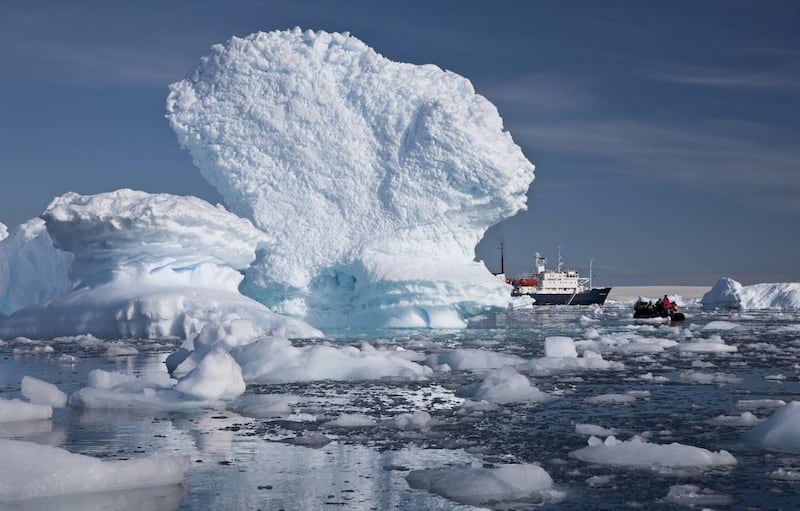There were four of us, rowing in pairs, attempting to break the record for crossing the Atlantic from west-to-east. A few days earlier, we had stood on Signal Hill above St John’s and watched an iceberg sail past the mouth of the harbour.
Viewed from the safety of that vantage point, the monstrous offspring of some distant Arctic glacier appeared awesome. Now with its kin, unseen in the fog but its chilling presence betrayed by a sudden drop in temperature, the adjective that sprang more readily to mind was sinister.
My rowing partner and I shipped our oars and strained our ears. From nearby came the inexplicable sound of water lapping against a shoreline – inexplicable because we were miles from land. The “shore”, we realised, was that of an invisible iceberg.
Unlike the Titanic, we would survive our encounter with an iceberg – our own sinking would take place a month later, at the hands of a storm some 250km south-west of Ireland.
The fury of that storm was something to behold, but over the years the memory of it has dulled. What has remained undiminished, however, is the sense of awe engendered by that unseen iceberg, the possessor of a kind of terrible kinetic energy and the very embodiment of that wild twilight zone in which human enterprise, for all our ingenuity, falls short.
It was that sense of helplessness in the face of one of nature’s most extraordinary manifestations that came to me when I read recently of a plan to harvest Antarctic icebergs and tow them north to the Gulf as a source of fresh water.
The “bizarre” plan, as it was described in the UK media, had been mooted by the National Advisor Bureau, a business start-up consultancy based in Abu Dhabi. In fact, towing icebergs from Antarctica to Fujairah was just one of several “what if” ideas for solving the UAE’s water problems first outlined in Filling the Empty Quarter, a book published in September 2015 by Abdulla Alshehi, the electronics engineer who founded the bureau.
Curiously, the late-breaking “news” coincided with the review of the final draft of the national water security strategy by the UAE’s Ministry of Energy, which felt the need to issue a statement that, “as the authority in charge of water affairs, it would like to confirm that such news is just a rumour”.
So that’s that, then. But should it be?
Icebergs, the product of snowfall, consist of fresh water, and the possibility of tapping that potential has been recognised for decades. For the UAE, which relies on the energy-intensive process of desalination for its water, the lack of natural sources could prove to be economically restrictive as the nation continues to grow.
Comparisons could, and should, be made with other sustainable technologies, in the development of which the UAE is playing a key role. Even a few years ago, who would have expected wind and solar power to play the significant role around the world they do today?
One of the earliest plans to harvest water from icebergs surfaced in 1949, as a proposed solution to California’s aridity. John D Isaacs, a professor at the Scripps Institution of Oceanography, outlined a scheme to tow an eight-billion-tonne iceberg, some 35km long, from Antarctica to San Diego. Off California, the iceberg would be surrounded “with a floating fence of impermeable material” from within which “the water can then be pumped from the fresh water lake that forms”.
The scheme evaporated, but dreamers continued to dream. In 1973 the US National Science Foundation sponsored a report by scientists at the Rand Corporation into the feasibility of exploiting “Antarctic icebergs as a global fresh water resource”. Reams of calculations were produced to demonstrate not only that it would be feasible to drive gigantic iceberg trains through the water, using nuclear-powered electric propellers fixed at intervals along the ice, but also that doing so would be ecologically harmless and considerably less expensive – in cash and environmental effect – than relying on desalination to generate the same amount of water.
The conclusion of the extensively researched and highly technical paper was that there was “no obvious insurmountable obstacle”.
Four years later, in October 1977, delegates from around the world gathered at Iowa State University for the First (and, as it would turn out, the last) International Conference on Iceberg Utilisation for Fresh Water Production. The conference was sponsored by, among others, Prince Mohammed Al Faisal of Saudi Arabia, who had a large block of ice flown in from Alaska as a PR stunt. The purpose of the conference, he told the media, was “to confirm our opinion that [icebergs] can be transported and that it can be done without any ecological difficulties at costs that are reasonable and in quantities that make a difference”.
As H Guyford Stever, former director of the US National Science Foundation and science adviser to presidents Nixon and Ford, put it, this was “big science” at its best, “a new and challenging conjunction of oceanography, meteorology, glaciology, solid mechanics and fluid mechanics with the technologies of ship design and operations at sea in hot and cold climes”.
As an ambition, he added, it was on a par with the space programme and all that was required now was “risk-taking, not only from the science and technology standpoint, but also as an entrepreneurial venture”.
It all led nowhere. Why? Politics and economics, probably. Ever since the embargo imposed by Opec countries in retaliation for US support of Israel during the 1973 war, oil prices had been in an upwards spiral, which would continue for years. Oil-rich Saudi Arabia, though one of the countries with the greatest need for an alternative to desalination, was under no great economic pressure to find one.
Forty years on from the Iowa conference the landscape of the Gulf, and the environmental consciousness of the entire world, has changed considerably. Back then the UAE was just six years old, a new nation finding its feet. Today it is one of the most influential players in the region, not only on account of its oil, but also thanks to its record of imaginative commitment to entrepreneurial and technological initiatives at the cutting edge of the global drive to sustainable living.
But it also faces a looming reality. Whatever emerges in the energy ministry’s awaited national water security strategy, the starting point is clear: in the uncomfortably near future, the UAE will need more water than it can afford to make.
What better home, then, than the UAE for the rebirth of the startling concept of mining water from icebergs, to be hauled 8,500km in a straight shot from Antarctica to the coast of Fujairah, and what better people to pull off such an audacious scheme than the dreamers who built towering cities where once was only sand?
Dreamers such as Abdulla Alshehi, perhaps. As he remarked in Filling the Empty Quarter in 2015, “All it takes is creativity and a bit of courage”.
Jonathan Gornall is a frequent contributor to The National





